How to Choose the Finest Auto Parts for Your Car
The performance and durability of your car depend on the periodic replacement of auto spare parts. Finding the greatest auto spare parts is crucial for the health of your automobile, whether you’re an enthusiast or a practical driver. This manual will lead you through finding the highest-quality components for your car.
1. Understand Your Car
It’s essential to have a thorough grasp of your car before you begin looking for auto replacement parts. Knowing the brand, model, year, and engine characteristics is a part of this. Knowing your car’s VIN (Vehicle Identification Number) helps you find out precisely what components you need. This information can help you choose suitable components.
2. Give genuine OEM parts priority
Genuine Original Equipment Manufacturer (OEM) components should always be chosen. These are the identical components that were utilized in the building of your car by the manufacturer. OEM components are very good in quality, dependability, and compatibility with your car. They are built to function at their best since they are made to the manufacturer’s requirements.
3. Review Your Car’s Manual
The owner’s handbook for your car is a great resource for learning about the necessary components and maintenance plans. It often details the precise components needed for regular maintenance and repairs. To choose the finest replacement parts for your car, consult this guidebook.
4. Look for Reliable Vendors
Do your homework and discover reliable suppliers and dealerships to obtain the greatest car components in your region. Find companies that have a reputation for offering genuine, high-quality components. Customer testimonials and referrals might provide insightful information about a supplier’s dependability.
5. Check Part Compatibility
Ensure the replacement components you’re considering are appropriate for your car. This entails ensuring the components are compatible with your particular model and adhere to your car’s requirements. To ensure a proper fit, it is important to cross-reference component numbers.
6. Keep Certified Auto Parts Shops in mind
Numerous car parts retailers provide certification systems that ensure the components they sell are high quality. The testing and quality control procedures for these certificates are sometimes quite demanding. You may feel confident in the components’ validity and dependability by purchasing from accredited retailers.
7. Verify the policies for warranties and returns
Reputable vendors often provide guarantees or return policies for the components they provide. If you have problems with the components after purchase, these policies provide peace of mind. Ensure you understand any warranties or return policies and their terms and conditions.
8. Examine Costs
Quality is important, but you should also check pricing from other providers. Remember that cheap pricing could signify poor quality. When making your choice, try to strike a balance between price and quality.
9. Consult a professional
Consult a dependable expert or mechanic if you need advice about the ideal replacement components for your car. They may provide knowledgeable counsel based on their expertise and experience, assisting you in making choices.
10. Carry out routine maintenance
Finally, maintain your car regularly to preserve its performance and lifespan. It’s crucial to repair worn-out or broken components as soon as possible. You can spot possible problems earlier on by doing routine maintenance.
11. Look into online markets
A wide variety of vehicle spare parts are available on online markets, including eBay, Amazon, and speciality auto parts websites. You may assess the calibre and dependability of the components using the customer evaluations and ratings often provided by these sites.
12. Participate in online automotive forums
Participating in online automobile forums and groups may be advantageous. Members often discuss their interactions with various providers and brands of replacement parts. You can learn which components are strongly advised and which you should avoid.
13. Examine aftermarket components
Although aftermarket components might sometimes be more affordable than OEM parts, OEM parts are recommended for their superior quality. But it’s crucial to do homework and choose trustworthy aftermarket manufacturers recognized for making durable, compatible components.
14. Inquire about Auto Recycling Facilities and Salvage Yards
Salvage yards and auto recycling facilities may be veritable gold mines of spare parts, particularly for older automobiles. Good used components are available for a small portion of the price of new ones.
15. Examine product labels and summaries
Read product labels and descriptions thoroughly before purchasing automotive replacement parts online or in-store. To be sure you’re buying the appropriate component, look for information such as material composition, manufacturing standards, and compatibility data.
16. Take into account remanufactured or refurbished parts
Used parts that have undergone extensive inspection, repair, and testing to meet or exceed OEM specifications are refurbished or remanufactured parts. These could be sensible financial and environmental choices.
17. Maintain a Maintenance Log
Please keep track of the replacement components you’ve bought, noting their part numbers, installation dates, and warranty details. You may monitor the performance and longevity of each component with the use of this record.






